KEROUAC, Jean Louis Lebris de ("Jack"), 1922-1969. Typescript scroll of On the Road (published 1957), comprising the first draft of the definitive Beat Generation novel, the working draft from which the published novel derives. Typed by Kerouac in New York City in a 20-day marathon between April 2 and 22, 1951. A continuous scroll of semi-translucent paper, 119 feet long 8 inches long by 9 inches wide, created by Kerouac by pasting and taping together separate 12-foot long strips in order to feed the scroll without interruption through the typewriter platen, the text single-spaced and entirely without paragraphs and exhibiting occasional cross-outs (by repeated "x"s), scattered, but fairly numerous penciled deletions and word changes, in some cases substituting fictional for the real names of himself and his companions and friends (Kerouac, Neal Cassady, Allen Ginsberg, William S. Burroughs), with occasional penciled deletions of phrases, entire lines and (in several places) whole blocks of text. Occasional interlinear and marginal notes in pencil by Kerouac. With Kerouac's name and address (at his mother's house) written in pencil on back of the scroll at the beginning: "John Kerouac, 94-21 134th Street, Richmond Hill, NY" (Kerouac and his mother's address from late 1952). A TWENTIETH-CENTURY MASTERPIECE The scroll typescript of On the Road arguably constitutes the most important manuscript of a late twentieth-century novel ever to be offered at auction. Certainly, it qualifies as the defining novel of the so-called Beat generation, a disparate group of poets, artists, filmmakers and musicians who shared certain broad philosophical affinities. The scroll of On the Road --which elicited much attention and comment at the time the book was published--also constitutes the most celebrated artifact of the Beat Generation. Nearly half a century after its writing, On the Road has attracted a wide and dedicated readership since its publication in 1957. And, unlike most novels with which it is contemporary, it continues to enjoy a sizeable readership in each successive generation. By far the most popular of Kerouac's works, On the Road strikingly portrays a mysterious, semi-nomadic subculture strikingly at variance with the conformist and materialistic American culture of the 1950s. To those courageous enough to reject the simplistic formulations of commercialized mass culture and embrace a new, unflinching truthfulness, the Beat movement held out a veiled but potent promise of heightened sensation, enhanced perception and a transforming sense of the potential of the individual. John Clellon Holmes, a member of Kerouac's circle, and author of the early beat novel Go , described the sense of excitement in the air in the early 1950s: "Everyone I knew felt it in one way or another--that bottled eagerness for talk, for joy, for excitement, for sensation, for new truths. Whatever the reason, everyone of my age had a look of impatience and expectation in his eyes that bespoke ungiven love, unreleased ecstasy and the presence of buried worlds within." In the legendary 20-day stint at the typewriter that has become part of Beat lore, Kerouac created a work so unique in its form and radical in its narrative that it was summarily rejected by a string of generally innovative editors and publishers. But Kerouac continued to write, voluminously. In the six years between the creation of the On the Road scroll and the book's publication, he completed at least eleven books and a large quantity of poetry and prose; refining the technique he later termed "spontaneous writing" or "sketching," which has been equated to the sinuous lines of modern jazz (which Kerouac loved) and to the drip technique of the painter Jackson Pollack, Kerouac's contemporary. As one critic has noted, Kerouac's "spontaneous bop prosody" (as Ginsberg termed it) "created an action painting of the word" (John Tytell, Naked Angels , p.209). Kerouac's friend Allen Ginsberg recogni
KEROUAC, Jean Louis Lebris de ("Jack"), 1922-1969. Typescript scroll of On the Road (published 1957), comprising the first draft of the definitive Beat Generation novel, the working draft from which the published novel derives. Typed by Kerouac in New York City in a 20-day marathon between April 2 and 22, 1951. A continuous scroll of semi-translucent paper, 119 feet long 8 inches long by 9 inches wide, created by Kerouac by pasting and taping together separate 12-foot long strips in order to feed the scroll without interruption through the typewriter platen, the text single-spaced and entirely without paragraphs and exhibiting occasional cross-outs (by repeated "x"s), scattered, but fairly numerous penciled deletions and word changes, in some cases substituting fictional for the real names of himself and his companions and friends (Kerouac, Neal Cassady, Allen Ginsberg, William S. Burroughs), with occasional penciled deletions of phrases, entire lines and (in several places) whole blocks of text. Occasional interlinear and marginal notes in pencil by Kerouac. With Kerouac's name and address (at his mother's house) written in pencil on back of the scroll at the beginning: "John Kerouac, 94-21 134th Street, Richmond Hill, NY" (Kerouac and his mother's address from late 1952). A TWENTIETH-CENTURY MASTERPIECE The scroll typescript of On the Road arguably constitutes the most important manuscript of a late twentieth-century novel ever to be offered at auction. Certainly, it qualifies as the defining novel of the so-called Beat generation, a disparate group of poets, artists, filmmakers and musicians who shared certain broad philosophical affinities. The scroll of On the Road --which elicited much attention and comment at the time the book was published--also constitutes the most celebrated artifact of the Beat Generation. Nearly half a century after its writing, On the Road has attracted a wide and dedicated readership since its publication in 1957. And, unlike most novels with which it is contemporary, it continues to enjoy a sizeable readership in each successive generation. By far the most popular of Kerouac's works, On the Road strikingly portrays a mysterious, semi-nomadic subculture strikingly at variance with the conformist and materialistic American culture of the 1950s. To those courageous enough to reject the simplistic formulations of commercialized mass culture and embrace a new, unflinching truthfulness, the Beat movement held out a veiled but potent promise of heightened sensation, enhanced perception and a transforming sense of the potential of the individual. John Clellon Holmes, a member of Kerouac's circle, and author of the early beat novel Go , described the sense of excitement in the air in the early 1950s: "Everyone I knew felt it in one way or another--that bottled eagerness for talk, for joy, for excitement, for sensation, for new truths. Whatever the reason, everyone of my age had a look of impatience and expectation in his eyes that bespoke ungiven love, unreleased ecstasy and the presence of buried worlds within." In the legendary 20-day stint at the typewriter that has become part of Beat lore, Kerouac created a work so unique in its form and radical in its narrative that it was summarily rejected by a string of generally innovative editors and publishers. But Kerouac continued to write, voluminously. In the six years between the creation of the On the Road scroll and the book's publication, he completed at least eleven books and a large quantity of poetry and prose; refining the technique he later termed "spontaneous writing" or "sketching," which has been equated to the sinuous lines of modern jazz (which Kerouac loved) and to the drip technique of the painter Jackson Pollack, Kerouac's contemporary. As one critic has noted, Kerouac's "spontaneous bop prosody" (as Ginsberg termed it) "created an action painting of the word" (John Tytell, Naked Angels , p.209). Kerouac's friend Allen Ginsberg recogni


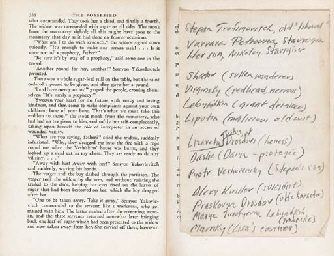






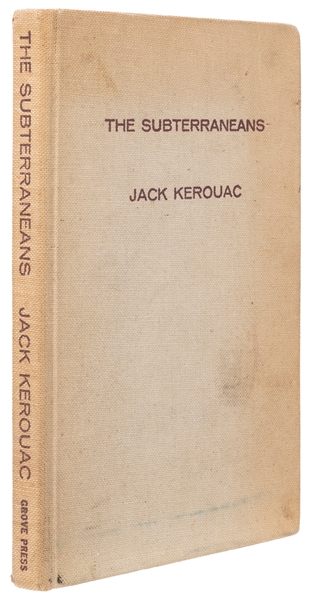
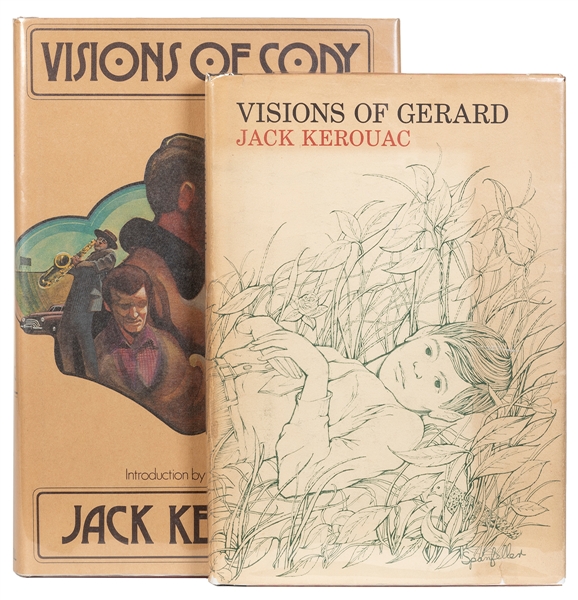
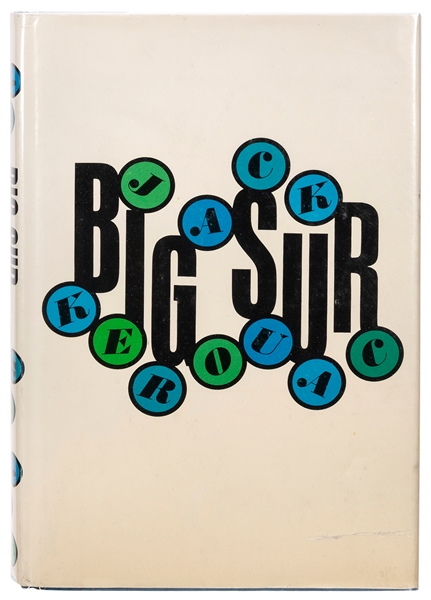

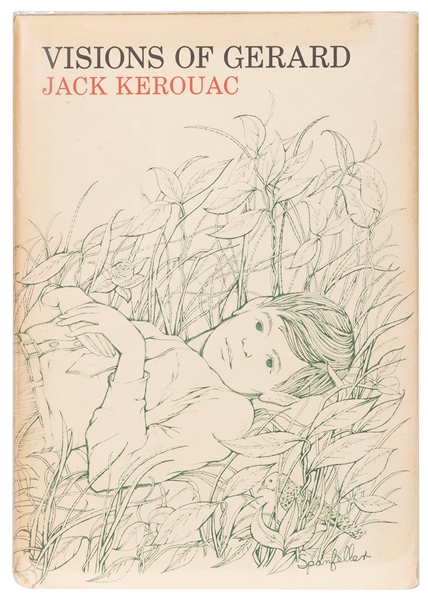
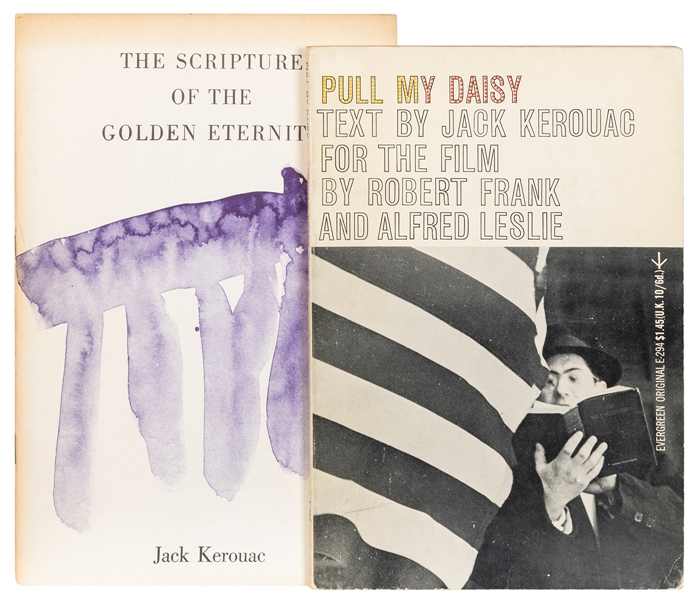
Testen Sie LotSearch und seine Premium-Features 7 Tage - ohne Kosten!
Lassen Sie sich automatisch über neue Objekte in kommenden Auktionen benachrichtigen.
Suchauftrag anlegen